Published
on 26
Jun 2018
|
All rights reserved.
|
|
|
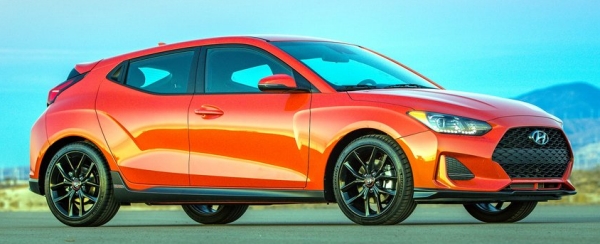
|
|
For
the first time, the Hyundai looks good enough to fill up the vacancy
left by VW Scirocco.
|
|
This is the second
generation Veloster, the odd 2-plus-1-door coupe from Korea. On paper,
the new car hasn’t changed much. It is merely 20mm longer and 10mm
wider, while wheelbase and height are both unchanged. The proportion is
hardly altered, too. However, in reality it feels like a much
different, much better car. You might remember all the problems of the
old car – a lackluster turbo engine, a poor DCT gearbox, poor ride,
handling and refinement… even the funky styling was not so well
accepted in the coupe segment. The new car might start from the same
profile, but its sheet metal gets sharper, crisper and sportier. The
roof line now rakes even faster towards the tailgate. For the first
time, the Hyundai looks good enough to fill up the vacancy left by
Volkswagen Scirocco.
That roof line could consume some rear headroom, but Hyundai claims the
latter is actually increased by 15mm, although you still can’t fit a 6
feet tall passenger there without seriously compromising his comfort.
Well, at least the small rear door on the kerb side helps easing access
to the rear seats, making the Veloster slightly more practical than
conventional coupes. Speaking of practicality, the new car also gets a
larger boot to take your weekend’s luggage. Its taillgate is tiny
compared with conventional hatchbacks, but boot space and access easily
trump small coupes like Honda Civic.
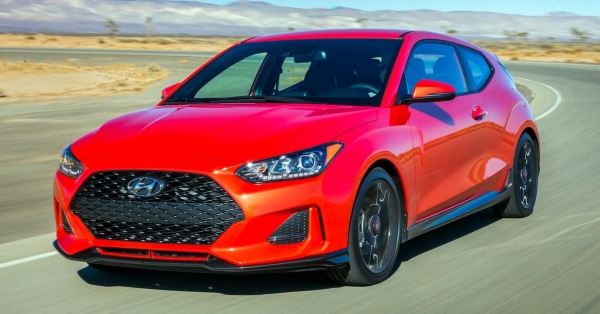 |
|
The
most promising has to be Albert Biermann...
|
|
The Veloster is derived from the underpinnings of i30 / Elantra GT.
Like the latter, model with the base engine rides on cheaper
torsion-beam rear axle, while turbocharged model is upgraded to a
multi-link
setup. The chassis is 28 percent stiffer than before, thanks to
increasing high-strength steel content to 52 percent, using structural
adhesives and more spot welds. This also lightens the body-in-white,
although extra equipment and the multi-link suspension added back the
weight. Some suspension parts, such as knuckles, are now made of
aluminum to cut unsprung weight a little.
However, the most promising has to be Albert Biermann. The former
engineering chief of BMW M-division has transformed the engineering
approach of i30N, and the new Veloster is also benefited from his
arrival. Otherwise, Hyundai would not have developed the N performance
version of Veloster, which will arrive in September. It will use the
same powertrain and many chassis mods of the i30N, but that will be
another story.
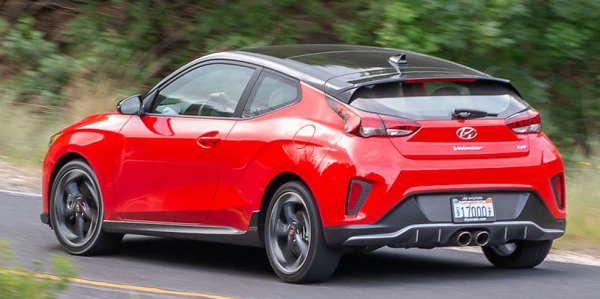
|
|
This is
probably the best driving Hyundai after the i30N.
|
|
Right now, we concentrate on the mass market Velosters. The base model
employs the 2-liter Atkinson-cycle engine from Elantra, offering 147hp
and 132 lbft of torque. It mates with a 6-speed manual or 6-speed auto.
Performance is inevitably unremarkable, especially when compared with
the
cooking model of Honda Civic Coupe (158hp 2.0-liter). Therefore, unless
your budget is very limited, you’d better to opt for the 1.6-liter
direct injection turbo. It sounds to be the same as the outgoing car’s,
producing the same 204hp (DIN, or 201hp SAE) and 195 pound-foot of
torque, but the latter arrives at 1500 rpm instead of the previous 1750
rpm. No wonder the engine feels more eager, punchier than before,
although its exhaust note remains dull. The new 6-speed manual gearbox
is also a huge improvement. Its short-throw gearshift is crisped and
the clutch takeup is smooth. Almost a match for the best manuals of
Honda and Mazda. Comparatively, the 7-speed DCT is disappointing, as
its manual gearshift is slow and sometimes jerky. The Veloster Turbo is
not going to match a Golf GTi for performance and mechanical
refinement, but it no longer feels disgraceful.
Ditto the chassis. The base car is forgettable, but the Turbo with its
more sophisticated rear axle and 15 percent stiffer suspension setup
results in decent ride and handling. Its body roll and pitch are much
better controlled than the past. The suspension soaks up bumps more
effectively. Noise is much better suppressed. The tires produce
abundance of grip. The steering is more accurate and linearly loaded,
although it still lacks feel. The brake pedal is well modulated. All
controls and responses are what you would expect from Albert
Biermann. The only criticism is the lack of an entertaining character
of, say, Ford Fiesta ST, as its tail refuses to step out on your
command. Then again, few others do. This is probably the best driving
Hyundai after the i30N.
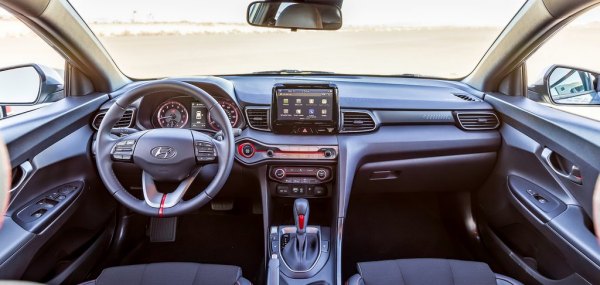
|
|
What the
Hyundai falls short of competition is the cabin...
|
|
What the Hyundai falls short of competition is the cabin, because it
remains ugly and cheap. Hard plastic is still the main theme, covering
most of the dash and door panels. It would have been better if Hyundai
gave it some tasteful color options or customizable trims, but these
are disappointingly omitted. Here is a dark and plain environment,
more suitable to a budget hatchback than a car whose selling point is
style and taste. Moreover, compared to a conventional hatchback, the
sloping back of Veloster sacrifices a great deal of rearward
visibility. It makes us wondering whether a pseudo coupe like this is a
smarter buy than a warm hatch. If Volkswagen cannot succeed with
Scirocco, why can Hyundai? Bring us the Veloster N and we'll think
again.
|
Verdict:    |
Published on 14
Aug 2018
|
All rights reserved.
|
|
Veloster N
|
|
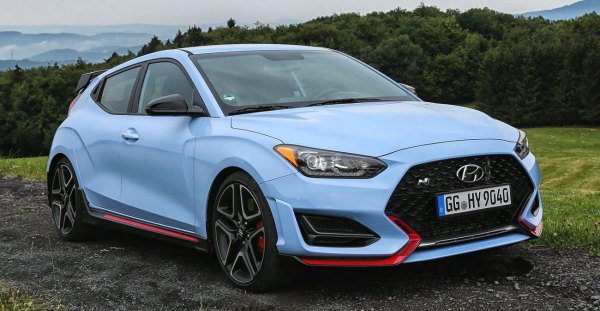
|
|
Veloster
looks, i30N underneath.
|
|
You won’t feel shocked to
see how good Veloster N drives, because you have already seen something
similar, i.e. i30N. Veloster N is just like the 3-door… er, 4-door
version of the i30N, which is gaining reputation as Hyundai’s first
ever true driver’s car in Europe. It shares not only the same engine
and transmission but also suspensions, tires, brakes… or much the same
chassis tuning done by ex-BMW M-division boss Albert Biermann in
Nurburgring. The biggest difference is, the Veloster aims at the
America where i30N is absent. They are twins separated by Atlantic.
They look very different though. While i30N is a conservative-looking
5-door hot hatch, Veloster N is just as funky as other Velosters.
Cosmetic enhancements are minor but pretty effective, including more
lip spoilers and a roof-mounted rear spoiler. Two large-diameter
exhausts are set further apart, sandwiching what looks like a diffuser.
If you like
Camaro or Challenger, you might like this one, too. If you appreciate
the understated beauty of Golf, it won’t be your cup of tea.
But you won’t buy any Velosters for looks. In the case of N, to drive
is the only reason. Thanks to Albert Biermann, this car has a good
mechanical package to support its ambition. Its monocoque is stiffened
by 7 percent thanks to extra bracings and weldings. Its 2-liter Turbo
engine produces 275 horsepower, easily more than Golf GTi, if not in
the league of Golf R or Civic Type R – those cars are more expensive
though. Not just figures, its power delivery is linear and there is
good response low down. 6-speed manual gearbox is the only option, but
it is a good one, providing slick and short-throw gearshifts. The front
axle has no problem to lay down the power either. It has an
electrohydraulic-controlled LSD like Golf GTi Performance, which
decides lock-up according to needs.
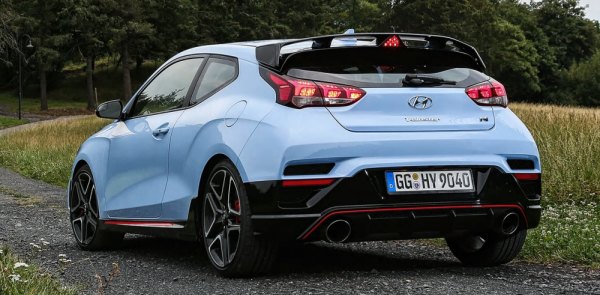
|
|
You
won’t buy any Velosters for looks. In the case of N, to drive is the
only reason.
|
|
The chassis is up to the job, too. Its 235/35R19 Pirelli P-Zero rubbers
offer bags of grip. The larger brakes work flawlessly. The rack-mounted
electrical power steering employed by N feels more natural than the
column-mounted cheap one of lesser Velosters. The Nurburgring-tuned
suspension and its adaptive dampers keep roll and understeer in check.
It is hard to find a particular weak area in its ride and handling.
Yes, the ride quality is a little firm, but no firmer than most
high-performance hot hatch on the market. Like i30N, it is very fast
and capable on twisty roads, but ultimately it is not quite as neutral
as or entertaining as Focus RS, Golf R or Civic Type R. Its exhaust
note is also a bit muted compared with rivals.
Like its sibling, the biggest drawback of Veloster N is a cheap cabin,
which offsets the effort Hyundai spent in recent years to wash away its
econo car image. The new sport bucket seats are pretty supportive and
comfortable, but otherwise this place looks just as dark and
uninspiring as the regular Veloster. On the flipside, the Veloster N is
a relative bargain, about the same price as a Golf GTi. Any European
hot hatches with similar performance cost considerably more. If that’s
not bargain enough, you can opt for the base model without performance
package. This means a 250hp version of the engine, the loss of LSD,
less sticky 18-inch Michelin Pilot Super Sports tires, marginally
smaller brakes and softer suspension tuning.
|
Verdict:     |
|